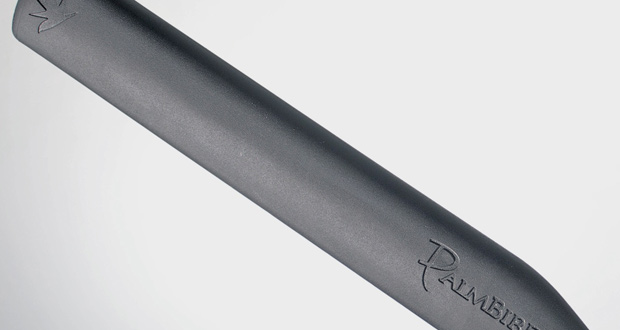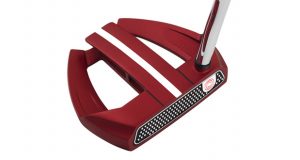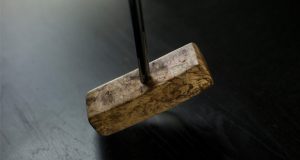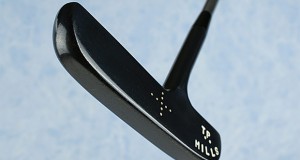We always admire entrepreneurs and inventors who not only have an idea for putting improvement, but who also have the guts to see the idea through from concept to finished product. One such product that recently crossed our desk is the Palmbird putter grip created by PGA professional Phillip Jaffe. Billed as a “putter grip and putting aid all-in-one,” the Palmbird bucks putter grip tradition by having no flat side along the front, and no tapering in the hands area. We caught up with Phillip to learn more about this distinctive putter grip. Following is our exclusive interview:
What makes the Palmbird putter grip different, and what benefits does it provide?
The Palmbird is unique in that its shape defines the way the hands fit on the grip. The groove at the back allows the fingers to lock into position for a secure hold without added muscular tension. With the convex front, instead of the flat front, this allows for more of the palm to cover the surface area of the grip, which gives you more stability during the stroke. The palm, when placed squarely on the Palmbird allows the golfer to hold it square and keep it square and the thumbs can relax in a natural anatomical position, without opposing forces. No flat side on the front makes it easier to maintain a square face throughout the stroke.
I realized the thumbs on traditional flat-sided grips must be engaged in order to place them on the flat side, which can create unnecessary added tension in the hands and forearms. Even though it’s slight, this also results in having opposing muscular contractions—thumbs pressing toward your body, while you are trying to move your shoulders in the opposite direction—which can alter the putter face during a stroke.
Additionally, the overall weight of the Palmbird is 169 grams, which provides counterbalance. Counterbalance is important in putting because it makes it easier to move the putter in a steady motion in the same plane. With lighter grips, the putter head feels heavy, and as a result, it requires more muscular control to keep the putter head steady along the line and from moving past the hands after midline. I like to think our weight is ideal in that it provides a 40 to 60 percent counterbalance to most putter heads on the market. Lengthening the shaft or adding weight in just the butt end of a putter can severely alter the balance. By having the weight of the grip in the material itself, it evens out the counterbalance and provides a great feel. As many PALMBIRD users say, “I feel an instant connection to the putter, as if it’s all one unit”.
Traditional putter grips are tapered, but the Palmbird is not. Can you elaborate on this feature, and why you think it offers golfers a better option that the standard tapered grips?
The Palmbird’s non-tapered design allows the golfer to maintain a balanced and light grip pressure in both hands, regardless of the how they hold it. With no taper there is no tension battle. Relaxed hands equals a relaxed stroke. In tapered designs, the bottom hand will inevitably be holding on tighter, because the diameter is smaller, so you won’t have balanced grip pressure in each hand. When there is a difference in hand tensions, there will be a battle between holding the putter and making a “relaxed” stroke. We feel the non-tapered design allows the golfer to concentrate more on the line and stroke instead of how they’re holding the grip. Testimonials from golfers using our grip, say they like the non-tapered style because it equalizes the hand pressures and allows the wrists to stay firm and ultimately keep the putter head square.
How was the Palmbird putter grip invented?
The idea for the design was happenstance! I was in the backyard cutting back a Bird of Paradise plant after a hard winter’s freeze. I was cutting the stalks and carrying them across the yard. I noticed that it was really easy to hold onto the stalks…there really was very little effort in my grasp. Which lead me to cut a putter length stalk…and I started making a putting motion with it. I noticed how fluid and steady my putting motion was. I made the connection that the shape of the stalk in my palm seemed to be the reason why it was easier for me to hold. It resulted in my arms being less tense and my shoulders were able to move with less restriction as well. I knew I was onto something. I modified the design to become what it is today.
Inventing a concept is one thing—manufacturing and bringing it to market is another. Can you briefly describe your journey from final concept to finished product?
I started back in 2005 with the discovery of the Bird of Paradise shape. I think the word “persistence” is the key. I believed I had something good and never gave up. I researched materials, designs, grip companies, tooling processes and the myriad of things associated with becoming a maker. I spoke with experts in the field at the PGA Show, as well. I started with my own sketches and then on to the engineering CAD drawings in which sample models were made, then back for modifications…Then, on to the Patent process, as well as the most important process, making sure my design conformed with USGA Rules. Finding a manufacturer was a little overwhelming, since most golf products are not made the United States. This led me to seek guidance from John Svenson of AME Grips in California at the time – now Gripo’s, LLC in Las Vegas. He was insightful and guided me through many of the processes and he ultimately became the manufacturer of the Palmbird.
Having it made in the USA is very satisfying and our grips’ material will last for decades. Bringing it to the market is a huge undertaking. I made mistakes along the way that were costly in both time and money. However, making those mistakes has been part of the growing and learning process. I now have a great golf product that is helping several thousand golfers (so far) putt better. I am very proud of accomplishing my initial goal of developing and testing the grip. We are now ready to move to the next level and get it in the hands of more golfers. Exhibiting at the PGA Show is a good start. We introduced the grip this year and will be at the PGA Show again next year. It’s a great venue to introduce our putter grip, as you have opportunities to get it in the hands of people you wouldn’t normally get to talk to. Presently, we are conducting demo days at local golf courses, support local charity golf events in Central Florida and have the Palmbird in many locations around the country. One of our biggest obstacles so far is getting the golfers that are using the Palmbird, to help us spread the word…they seem to be enjoying keeping it as their little secret!
You mentioned that a smaller model is in the works. Can you tell us what’s next from Palmbird? And are you trying to get the Palmbird in use on the professional tours?
We have a smaller model in the works – about 18 percent smaller. This is in response to many golfers who have expressed interest in a smaller Palmbird, as they love the shape and weight but would like something a bit smaller to suit their own personal style of putting. The newer model will also fit better in the hands of junior golfers. The Palmbird is available on the PGA Tour in one of the authorized PGA Tech Van’s owned by Scott Garrison, of ScottEGGolf. We know of a few professionals on different tours that have recently discovered our grip. We understand that it takes time for a small business, like ours to expand by organic growth and that we’ll need to be patient and stay the course. In the meantime, we are happy to help all golfers, no matter their level, putt better. We look forward to having many more golfers experience the joy of putting with the Palmbird.
 PutterZone – Best Putter Reviews
PutterZone – Best Putter Reviews




